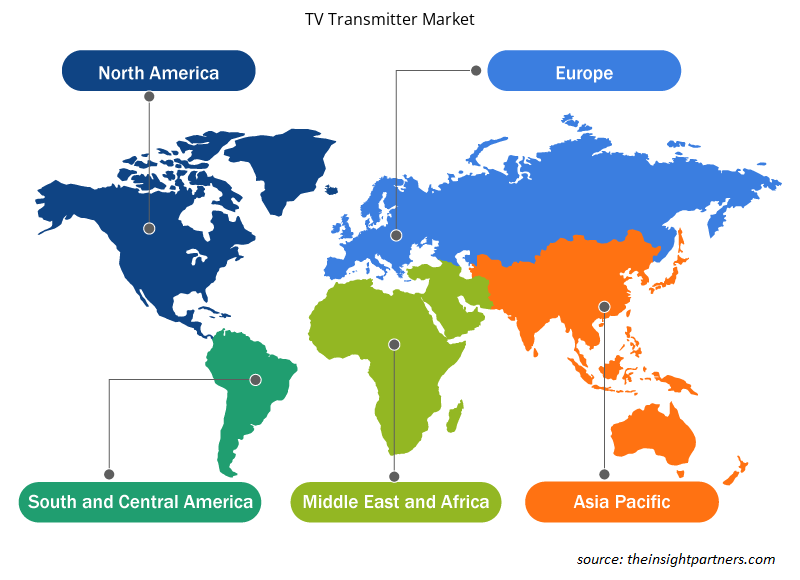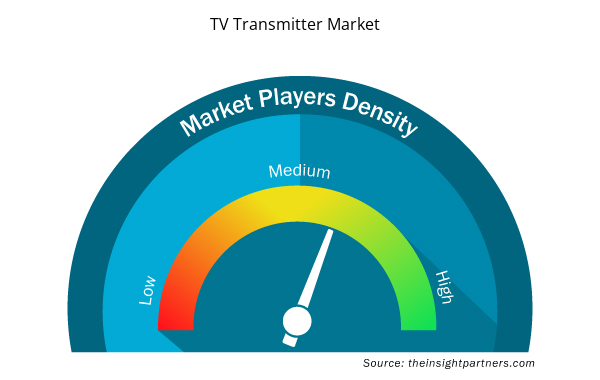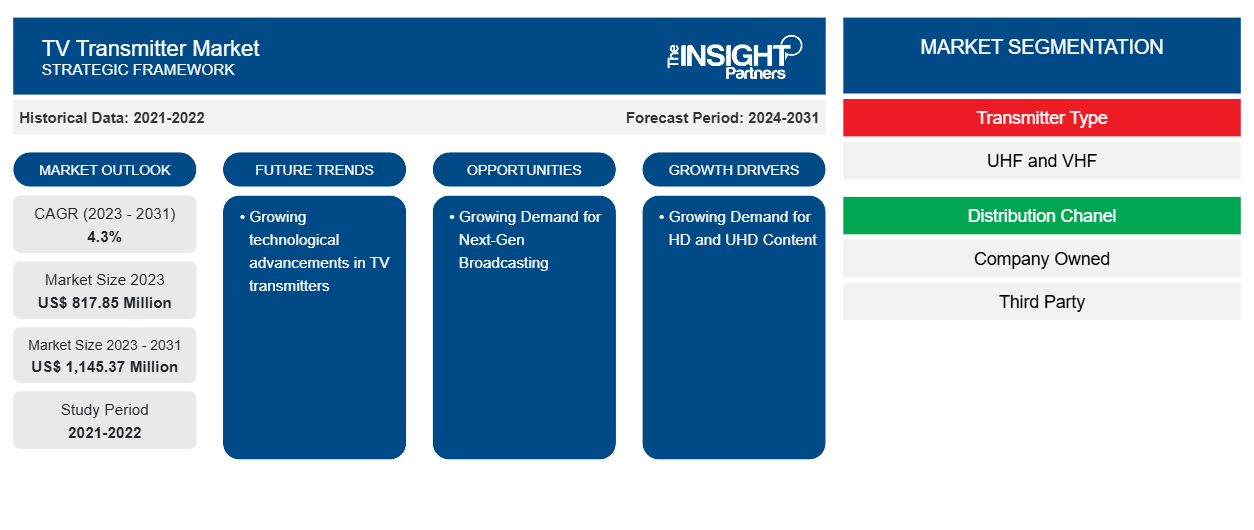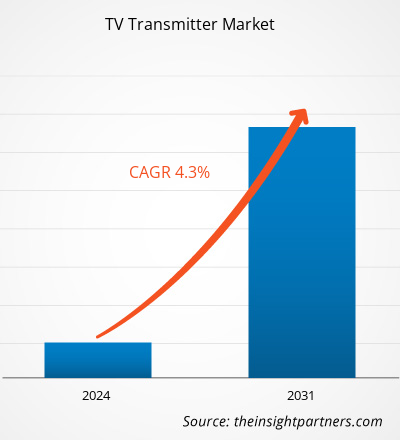Der Markt für Fernsehsender soll von 817,85 Millionen US-Dollar im Jahr 2023 auf 1.145,37 Millionen US-Dollar im Jahr 2031 anwachsen. Der Markt soll zwischen 2023 und 2031 eine durchschnittliche jährliche Wachstumsrate (CAGR) von 4,3 % verzeichnen. Die steigende Nachfrage nach hochauflösenden Inhalten dürfte ein wichtiger Trend auf dem Markt für Fernsehsender bleiben.CAGR of 4.3% in 2023–2031. The increasing demand for high-definition content is likely to remain a key TV Transmitter Market trend.
TV-Sender Marktanalyse
Die weltweit steigende Nachfrage nach HD- und UHD-Inhalten ist einer der Hauptfaktoren, die das Wachstum des TV-Sendermarktes antreiben. Darüber hinaus treiben die ständigen Innovationen im Telekommunikations- und Rundfunksektor das Wachstum des TV-Sendermarktes voran. Darüber hinaus wird erwartet, dass die steigende Nachfrage nach Rundfunk der nächsten Generation das Wachstum des Marktes im Prognosezeitraum ankurbeln wird. Darüber hinaus schaffen die wachsenden technologischen Fortschritte bei TV-Sendern eine Chance für das Wachstum des TV-Sendermarktes in den kommenden Jahren.
Marktübersicht für TV-Sender
Ein Fernsehsender ist ein elektrisches Gerät, das Radiowellen aussendet, die sowohl das Videosignal mit einem dynamischen Bild als auch das damit synchronisierte Audiosignal übertragen. Es wird von einem Fernsehempfänger empfangen, der das Bild auf dem Bildschirm anzeigt und den dazu passenden Ton wiedergibt. Seine Betriebsfrequenz ist auf die Frequenzbänder VHF und UHF beschränkt und seine Ausgangsleistung reicht von 5 W bis 10 kW. Er wird häufig im Bereich der Fernsehübertragung , beispielsweise bei Fernsehsendern, eingesetzt.
Passen Sie diesen Bericht Ihren Anforderungen an
Sie erhalten kostenlose Anpassungen an jedem Bericht, einschließlich Teilen dieses Berichts oder einer Analyse auf Länderebene, eines Excel-Datenpakets sowie tolle Angebote und Rabatte für Start-ups und Universitäten.
- Holen Sie sich die wichtigsten Markttrends aus diesem Bericht.Dieses KOSTENLOSE Beispiel umfasst eine Datenanalyse von Markttrends bis hin zu Schätzungen und Prognosen.
Treiber und Chancen auf dem TV-Sendermarkt
Steigende Nachfrage nach HD- und UHD-Inhalten
Die Nachfrage nach High-Definition- (HD) und Ultra-High-Definition- (UHD) Inhalten steigt bei Verbrauchern weltweit, insbesondere weil sie Audio und Video in höherer Qualität bieten. Darüber hinaus nimmt die Nutzung von OTT-Plattformen weltweit zu, zusammen mit der Veröffentlichung hochwertiger Inhalte. Somit treibt die steigende Nachfrage nach qualitativ hochwertigen Inhalten das Wachstum des TV-Sendermarktes an.
AnbauNachfrage nach Next-Gen-Broadcasting
Next-Gen Broadcasting umfasst die Einführung digitaler Rundfunkstandards, wobei verschiedene Regionen auf der ganzen Welt bestimmte Standards wie ATSC 3.0 in den Vereinigten Staaten, DVB-T2 in Europa und ISDB-Tb in bestimmten Teilen Asiens und Südamerikas übernehmen. Zu den Vorteilen dieser Standards gehören eine verbesserte Audio- und Videoqualität, eine effektivere Nutzung des verfügbaren Spektrums und die Hinzufügung neuer interaktiver Funktionen. Der Übergang zu digitalen Rundfunkstandards erleichtert die Übertragung von hochauflösenden (HD) und ultrahochauflösenden (UHD) Programmen, was den Zuschauern ein viel besseres Bild- und Tonerlebnis bietet und ihren Fernsehgenuss steigert. Daher wird erwartet, dass die wachsende Nachfrage nach Next-Gen-Rundfunk eine Chance für das Wachstum des TV-Sendermarktes schafft.ATSC 3.0 in the United States, DVB-T2 in Europe, and ISDB-Tb in certain sections of Asia and South America. Benefits from these standards include improved audio and video quality, more effective use of available spectrum, and the addition of new interactive features. The transition to digital broadcasting standards makes it easier to transmit high-definition (HD) and ultra-high-definition (UHD) programming, which gives viewers a much better visual and audio experience and increases their enjoyment of television. Thus, the growing demand for next-gen broadcasting is expected to create an opportunity for the growth of the TV transmitter market.
Segmentierungsanalyse des TV-Sender-Marktberichts
Wichtige Segmente, die zur Ableitung der Marktanalyse für Fernsehsender beigetragen haben, sind Sendertyp, Vertriebskanal und Anwendung.
- Basierend auf dem Sendertyp ist der Markt für Fernsehsender in UHF und VHF unterteilt. Das UHF-Segment hatte 2023 einen größeren Marktanteil. Das UHF-Segment ist weiter in niedrig, mittel und hoch unterteilt. Ebenso ist das VHF-Segment weiter in niedrig und mittel unterteilt.
- Nach Vertriebskanal ist der Markt in unternehmenseigene und Drittanbieter-Segmente unterteilt. Das Segment „unternehmenseigene“ hielt im Jahr 2023 den größten Marktanteil.
- Nach Anwendung ist der Markt in kleine und große Fernsehsender unterteilt. Das Segment der großen Fernsehsender hatte im Jahr 2023 den größten Marktanteil.
Marktanteilsanalyse für TV-Sender nach geografischer Lage
Der geografische Umfang des Marktberichts für Fernsehsender ist hauptsächlich in fünf Regionen unterteilt: Nordamerika, Asien-Pazifik, Europa, Naher Osten und Afrika sowie Südamerika/Süd- und Mittelamerika.
In Bezug auf den Umsatz hatte der asiatisch-pazifische Raum den größten Marktanteil bei Fernsehsendern. Der Markt in dieser Region ist in Australien, China, Indien, Südkorea, Japan und den Rest des asiatisch-pazifischen Raums unterteilt. Die Marktteilnehmer in der Region arbeiten kontinuierlich an technologischen Fortschritten im Rundfunksektor, was der Hauptfaktor für das Wachstum des Fernsehsendermarkts im asiatisch-pazifischen Raum ist. Darüber hinaus erlebt die Region ein enormes Wachstum in ihrer Medien- und Unterhaltungsbranche, was das Wachstum des Fernsehsendermarkts weiter ankurbelt.
Regionale Einblicke in den TV-Sendermarkt
Die regionalen Trends und Faktoren, die den Markt für Fernsehsender im Prognosezeitraum beeinflussen, wurden von den Analysten von Insight Partners ausführlich erläutert. In diesem Abschnitt werden auch die Marktsegmente und die Geografie von Fernsehsendern in Nordamerika, Europa, im asiatisch-pazifischen Raum, im Nahen Osten und Afrika sowie in Süd- und Mittelamerika erörtert.

- Erhalten Sie regionale Daten zum Markt für Fernsehsender
Umfang des Marktberichts zu Fernsehsendern
| Berichtsattribut | Details |
|---|---|
| Marktgröße im Jahr 2023 | 817,85 Millionen US-Dollar |
| Marktgröße bis 2031 | 1.145,37 Millionen US-Dollar |
| Globale CAGR (2023 - 2031) | 4,3 % |
| Historische Daten | 2021-2022 |
| Prognosezeitraum | 2024–2031 |
| Abgedeckte Segmente | Nach Sendertyp
|
| Abgedeckte Regionen und Länder | Nordamerika
|
| Marktführer und wichtige Unternehmensprofile |
|
Dichte der Marktteilnehmer für Fernsehsender: Auswirkungen auf die Geschäftsdynamik verstehen
Der Markt für TV-Sender wächst rasant, angetrieben durch die steigende Nachfrage der Endnutzer aufgrund von Faktoren wie sich entwickelnden Verbraucherpräferenzen, technologischen Fortschritten und einem größeren Bewusstsein für die Vorteile des Produkts. Mit steigender Nachfrage erweitern Unternehmen ihr Angebot, entwickeln Innovationen, um die Bedürfnisse der Verbraucher zu erfüllen, und nutzen neue Trends, was das Marktwachstum weiter ankurbelt.
Die Marktteilnehmerdichte bezieht sich auf die Verteilung der Firmen oder Unternehmen, die in einem bestimmten Markt oder einer bestimmten Branche tätig sind. Sie gibt an, wie viele Wettbewerber (Marktteilnehmer) in einem bestimmten Marktraum im Verhältnis zu seiner Größe oder seinem gesamten Marktwert präsent sind.
Die wichtigsten auf dem Markt für Fernsehsender tätigen Unternehmen sind:
- Rohde and Schwarz
- NEC Corp
- Hitachi Kokusai Electric Group
- BTESA
- Egatel
- Gates Luft
Haftungsausschluss : Die oben aufgeführten Unternehmen sind nicht in einer bestimmten Reihenfolge aufgeführt.

- Überblick über die wichtigsten Akteure auf dem Markt für Fernsehsender
Neuigkeiten und aktuelle Entwicklungen auf dem TV-Sendermarkt
Der Markt für Fernsehsender wird durch die Erhebung qualitativer und quantitativer Daten nach Primär- und Sekundärforschung bewertet, die wichtige Unternehmensveröffentlichungen, Verbandsdaten und Datenbanken umfasst. Im Folgenden finden Sie eine Liste der Entwicklungen auf dem Markt für Sprach- und Sprechstörungen sowie Strategien:
- ENENSYS Technologies, ein führender Anbieter von Medienbereitstellungslösungen, und ELECTROLINK, ein italienischer Hersteller von Fernsehsendern, gaben bekannt, dass sie alle in den Regionen Abruzzen, Latium und Ligurien betriebenen DVB-T/T2-Sendersysteme im Rahmen des im Rahmen einer öffentlichen Ausschreibung vergebenen Umstrukturierungsprojekts in Italien erfolgreich an Rai Way geliefert haben. ENENSYS und ELECTROLINK haben für dieses Projekt eine besondere Partnerschaft aufgebaut, bei der jedes Unternehmen die besten Komponenten und Ingenieurdienstleistungen liefert, um Rai Way das effizienteste, zuverlässigste und modernste DVB-T/T2-Sendersystem zu liefern. (Quelle: ENENSYS Technologies, Pressemitteilung, 2023)
- Hope Channel Central Philippines hat das neue Studio und den neuen Sendestandort am Hauptsitz der Central Philippine Union Conference (CPUC) in Cebu City, Philippinen, eingeweiht. (Quelle: Adventisten, Pressemitteilung, 2023)
Marktbericht zu Fernsehsendern – Abdeckung und Ergebnisse
Der Bericht „Marktgröße und Prognose für TV-Sender (2021–2031)“ bietet eine detaillierte Analyse des Marktes, die die folgenden Bereiche abdeckt:
- Marktgröße und Prognose auf globaler, regionaler und Länderebene für alle wichtigen Marktsegmente, die im Rahmen des Projekts abgedeckt sind
- Marktdynamik wie Treiber, Beschränkungen und wichtige Chancen
- Wichtige Zukunftstrends
- Detaillierte PEST/Porters Five Forces- und SWOT-Analyse
- Globale und regionale Marktanalyse mit wichtigen Markttrends, wichtigen Akteuren, Vorschriften und aktuellen Marktentwicklungen
- Branchenlandschaft und Wettbewerbsanalyse, einschließlich Marktkonzentration, Heatmap-Analyse, prominenten Akteuren und aktuellen Entwicklungen
- Detaillierte Firmenprofile
- Historische Analyse (2 Jahre), Basisjahr, Prognose (7 Jahre) mit CAGR
- PEST- und SWOT-Analyse
- Marktgröße Wert/Volumen – Global, Regional, Land
- Branche und Wettbewerbsumfeld
- Excel-Datensatz



Report Coverage
Revenue forecast, Company Analysis, Industry landscape, Growth factors, and Trends

Segment Covered
This text is related
to segments covered.

Regional Scope
North America, Europe, Asia Pacific, Middle East & Africa, South & Central America

Country Scope
This text is related
to country scope.
Häufig gestellte Fragen
The global TV transmitter market was estimated to be US$ 817.85 million in 2023 and is expected to grow at a CAGR of 4.3% during the forecast period 2023 - 2031.
Growing demand for HD and UHD content are the major factors that propel the global TV transmitter market.
Growing technological advancements in TV transmitters are anticipated to play a significant role in the global TV transmitter market in the coming years.
The key players holding majority shares in the global TV transmitter market are Rohde and Schwarz, NEC Corp, Hitachi Kokusai Electric Group, BTESA, Egatel, Gates Air, Toshiba, Gospell Digital Technology Co., Ltd., Plisch, and Syes.
The global TV transmitter market is expected to reach US$ 1,145.37 million by 2031.
Trends and growth analysis reports related to Electronics and Semiconductor : READ MORE..
The Insight Partners performs research in 4 major stages: Data Collection & Secondary Research, Primary Research, Data Analysis and Data Triangulation & Final Review.
- Data Collection and Secondary Research:
As a market research and consulting firm operating from a decade, we have published and advised several client across the globe. First step for any study will start with an assessment of currently available data and insights from existing reports. Further, historical and current market information is collected from Investor Presentations, Annual Reports, SEC Filings, etc., and other information related to company’s performance and market positioning are gathered from Paid Databases (Factiva, Hoovers, and Reuters) and various other publications available in public domain.
Several associations trade associates, technical forums, institutes, societies and organization are accessed to gain technical as well as market related insights through their publications such as research papers, blogs and press releases related to the studies are referred to get cues about the market. Further, white papers, journals, magazines, and other news articles published in last 3 years are scrutinized and analyzed to understand the current market trends.
- Primary Research:
The primarily interview analysis comprise of data obtained from industry participants interview and answers to survey questions gathered by in-house primary team.
For primary research, interviews are conducted with industry experts/CEOs/Marketing Managers/VPs/Subject Matter Experts from both demand and supply side to get a 360-degree view of the market. The primary team conducts several interviews based on the complexity of the markets to understand the various market trends and dynamics which makes research more credible and precise.
A typical research interview fulfils the following functions:
- Provides first-hand information on the market size, market trends, growth trends, competitive landscape, and outlook
- Validates and strengthens in-house secondary research findings
- Develops the analysis team’s expertise and market understanding
Primary research involves email interactions and telephone interviews for each market, category, segment, and sub-segment across geographies. The participants who typically take part in such a process include, but are not limited to:
- Industry participants: VPs, business development managers, market intelligence managers and national sales managers
- Outside experts: Valuation experts, research analysts and key opinion leaders specializing in the electronics and semiconductor industry.
Below is the breakup of our primary respondents by company, designation, and region:

Once we receive the confirmation from primary research sources or primary respondents, we finalize the base year market estimation and forecast the data as per the macroeconomic and microeconomic factors assessed during data collection.
- Data Analysis:
Once data is validated through both secondary as well as primary respondents, we finalize the market estimations by hypothesis formulation and factor analysis at regional and country level.
- Macro-Economic Factor Analysis:
We analyse macroeconomic indicators such the gross domestic product (GDP), increase in the demand for goods and services across industries, technological advancement, regional economic growth, governmental policies, the influence of COVID-19, PEST analysis, and other aspects. This analysis aids in setting benchmarks for various nations/regions and approximating market splits. Additionally, the general trend of the aforementioned components aid in determining the market's development possibilities.
- Country Level Data:
Various factors that are especially aligned to the country are taken into account to determine the market size for a certain area and country, including the presence of vendors, such as headquarters and offices, the country's GDP, demand patterns, and industry growth. To comprehend the market dynamics for the nation, a number of growth variables, inhibitors, application areas, and current market trends are researched. The aforementioned elements aid in determining the country's overall market's growth potential.
- Company Profile:
The “Table of Contents” is formulated by listing and analyzing more than 25 - 30 companies operating in the market ecosystem across geographies. However, we profile only 10 companies as a standard practice in our syndicate reports. These 10 companies comprise leading, emerging, and regional players. Nonetheless, our analysis is not restricted to the 10 listed companies, we also analyze other companies present in the market to develop a holistic view and understand the prevailing trends. The “Company Profiles” section in the report covers key facts, business description, products & services, financial information, SWOT analysis, and key developments. The financial information presented is extracted from the annual reports and official documents of the publicly listed companies. Upon collecting the information for the sections of respective companies, we verify them via various primary sources and then compile the data in respective company profiles. The company level information helps us in deriving the base number as well as in forecasting the market size.
- Developing Base Number:
Aggregation of sales statistics (2020-2022) and macro-economic factor, and other secondary and primary research insights are utilized to arrive at base number and related market shares for 2022. The data gaps are identified in this step and relevant market data is analyzed, collected from paid primary interviews or databases. On finalizing the base year market size, forecasts are developed on the basis of macro-economic, industry and market growth factors and company level analysis.
- Data Triangulation and Final Review:
The market findings and base year market size calculations are validated from supply as well as demand side. Demand side validations are based on macro-economic factor analysis and benchmarks for respective regions and countries. In case of supply side validations, revenues of major companies are estimated (in case not available) based on industry benchmark, approximate number of employees, product portfolio, and primary interviews revenues are gathered. Further revenue from target product/service segment is assessed to avoid overshooting of market statistics. In case of heavy deviations between supply and demand side values, all thes steps are repeated to achieve synchronization.
We follow an iterative model, wherein we share our research findings with Subject Matter Experts (SME’s) and Key Opinion Leaders (KOLs) until consensus view of the market is not formulated – this model negates any drastic deviation in the opinions of experts. Only validated and universally acceptable research findings are quoted in our reports.
We have important check points that we use to validate our research findings – which we call – data triangulation, where we validate the information, we generate from secondary sources with primary interviews and then we re-validate with our internal data bases and Subject matter experts. This comprehensive model enables us to deliver high quality, reliable data in shortest possible time.


 Holen Sie sich ein kostenloses Muster für diesen Bericht
Holen Sie sich ein kostenloses Muster für diesen Bericht